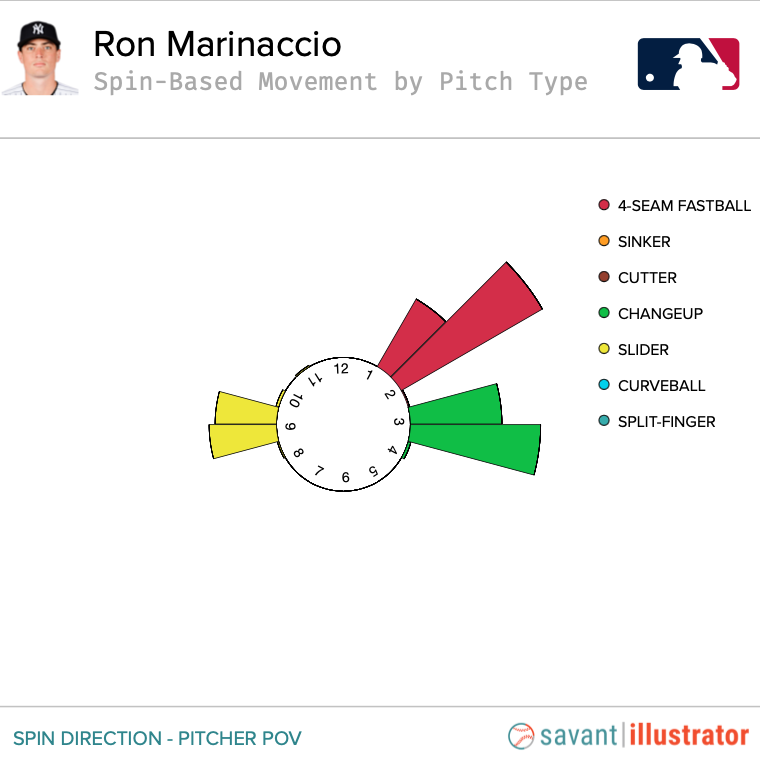The thing about major league hitters is, they’re good. A pitcher can have the best pitch in the world, but if a hitter knows what’s coming, they’ll adjust accordingly and quickly. Pitch repertoires for that reason are complicated things. Each pitch plays off of the other while setting up the next. Devin Williams‘ changeup is set up by his fastball, Ohtani’s splitter keeps hitters off the slider, et cetera.
Pitchers, however, are also very good at baseball. In particular pitching. As a result, some have pitches that while not the primary offering, are also very good either in a vacuum or when paired with other arrows in the quiver.
Let’s take a moment to appreciate five underrated pitches in MLB that maybe aren’t the first pitch you associate with the player, but nonetheless are worthwhile keeping an eye out for, whether to see what comes of that pitch in the overall results or simply to appreciate it’s gif-iness on its own.
Connor Brogdon, Phillies: Cutter
https://gfycat.com/lightachinghart
The cutter is Brogdon’s best pitch, but perhaps we don’t fully appreciate how good it is. Only three other players last year had at least four inches of vertical drop on their cutter while maintaining a positive horizontal break, and one of them was cutter Picasso Kenley Jansen.
For his part, Brogdon has gotten more and more comfortable with the pitch as he steadily increases his usage of it year over year, going from 16% in 2020 to 19% in 2021 to 24% in 2022, mostly at the expense of the four-seamer.
What makes Brogdon’s pitch underrated, though, is that he was actually a bit unlucky with the cutter last year, despite earning whiffs on nearly 35% of them that he threw. His expected batting average and slugging percentages against the pitch are in line with his excellent career averages, but the actual results were drastically different:
Even if Brogdon continues his cutter usage at the same rate as last season, he’s likely to see better results from it, and that could make him an even more dangerous weapon in the Phillies’ bullpen.
Ethan Small, Brewers: Changeup
https://gfycat.com/darlingcandideeve
There’s not a ton to remember about six and two-thirds innings of 7.11 ERA baseball from Milwaukee’s #12 prospect, while hitting 91 with his four-seam fastball.
But the changeup is something else.
Small throws it a full twelve miles per hour slower than his fastball and generated 39% whiffs on the pitch in his limited 2022 against big league hitters. Now, when hitters did make contact, they really crushed it to the tune of a .667 slugging percentage. However, like Connor Brogdon, the x-stats tell a different story, with Small’s changeup registering a tiny .180 xBA and .271 xSLG.
For now, hitters can just sit on Small’s fastball– he’ll likely need another pitch to unleash the full potential of his changeup. Small did experiment with a slider in the majors last year, throwing it five times. If he can keep hitters off balance a little more, that changeup could be one of the best in the big leagues.
Ron Marinaccio, Yankees: Slider
https://gfycat.com/freshwebbedblowfish
Marinaccio’s slider gets a ton of horizontal movement—21% more than the average major league slider. Across 44 innings in 2022, Marinaccio was extremely effective, pitching to a 2.05 ERA and 1.05 WHIP while only using that bendy slider 18% of the time. It’s hard to fault that usage, however, given his even more-effective changeup (41% whiffs and .216 xSLG).
The slider on its own is pretty good though—and again was a victim of a much higher SLG against than his underlying peripherals would suggest (.400 SLG against, .216 xSLG). The really intriguing thing about the slider is its use in tandem with the change. Coming out of his hand, they look almost identical to the batter:

Marinaccio’s slider should be appreciated on its own, but really it should get bonus points for making that devastating changeup all the more effective.
Liam Hendriks, White Sox: Curveball
https://gfycat.com/miserableclassicgodwit
While Hendriks is primarily known for his fastball/slider combo, let’s show a little appreciation to Hendrik’s curve as well. He gets almost as many whiffs on the curve (63%) as the slider (67%).
After Hendriks’ four-seamer struggled a bit by his lofty standards in 2021, he adjusted and started throwing the much more effective slider in its place in 2022 to great success. He’s basically the perfect pitcher, in that he has multiple high-quality pitches that can effectively replace each other depending on what’s working that plate appearance or season.
If for some reason his four-seamer continues to decline or hitters sit on the slider, he can rely on the curve even more. He’s slowly but surely increased its usage each of the past three seasons up to 10.5% in 2022.
What’s more, Hendriks was a bit unlucky with the curve last season. Assuming his .102 xWOBA (!) on the curve is closer to his “true” talent than the .256 wOBA on the pitch from last year, it might be his best pitch and one that could stave off any near-term decline.
Gerrit Cole, Yankees: Curveball
https://gfycat.com/adeptmedicalgypsymoth
It’s admittedly a bit weird to think of one of the best pitchers in baseball having an “underrated” pitch, but Cole likely fits the bill. It’s not just a “good” pitch, but should instead really be recognized as one of the best curveballs in the game.
With the curveball, spin is king. Only curveball-heavy pitchers Charlie Morton, Julio Urías, and Framber Valdez get more spin on theirs than Gerrit Cole. And, among pitchers who get at least 2700 revolutions per minute on uncle Charlie, nobody throws theirs less than Cole, and he does so about 30% less than the next lowest pitcher to hit that mark (Jameson Taillon).
The fastball and slider are so good for Cole that he doesn’t need to turn to the curveball that often, but when he does it has been extremely effective, generating swings and misses on 37% of them. It gets significantly more movement than the average curve. He has steadily increased the amount of “drop” on the pitch over the past few seasons while maintaining the horizontal movement.
Cole hasn’t had to throw his curveball quite as much, but might consider dropping it in more than the 10% he throws it, as it gets more whiffs than his four-seamer which he throws over half the time. Cole’s spin mirroring (how closely the spins look similar coming out of his hand to hitters) is very close to his four-seamer, so mixing in the curve more could throw hitters more off-balance and then later put away with the slider.
There isn’t an identifiable “perfect” pitch mix, for Cole or any other pitcher. Pitches work in concert with each other, so even with effective or high-potential pitches, it’s not as simple as suggesting a pitcher throw it more often. They sure are fun to watch, though.
Photo by Mark LoMoglio/Icon Sportswire | Leslie Plaza

